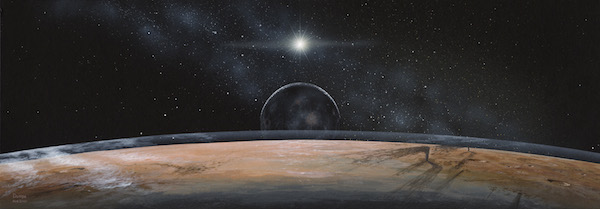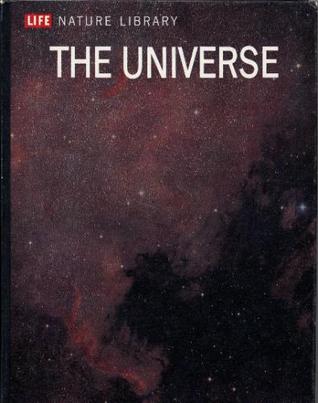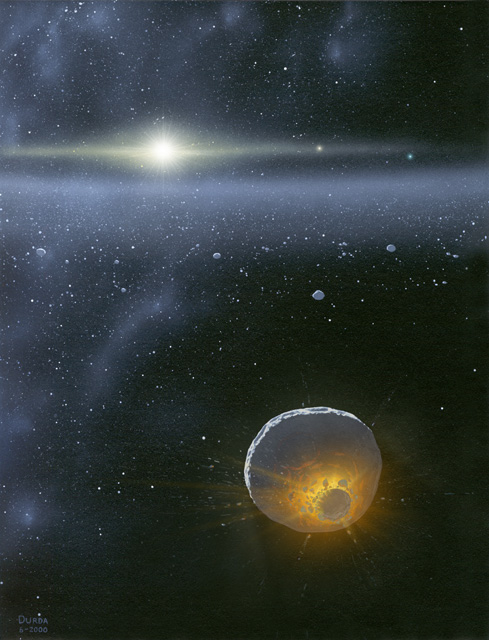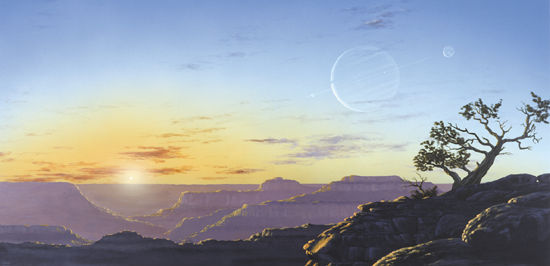by Dan Durda
- Published: Wednesday, October 15 2014 23:41

Title: “New Horizons by Dan Durda”
Caption: “Completed for the New Horizons mission to Pluto before the spacecraft was even built and launched. This was my guess at some of the interesting geological features and activity that we might see when we finally see Pluto up close for the first time. When asked at the post-launch party in 2006 to write on a poster my prediction for what we might see in 2015 I wrote, ‘I predict that Pluto will look nothing like my painting.’ We’ll soon see...”
As a professional astronomer who spends a lot of time generating space art, I'm often asked to comment on the seeming incongruity of someone working more or less equally comfortably in these at first apparently polar opposite worlds. The ‘ole right brain, left brain, creative ‘versus’ technical thing. To tell you the truth, I've never noticed or given it a second thought - it has always seemed rather natural.
There was never really any doubt that I was going to end up in a career in science. For as long as I can remember I was always fascinated with the natural world. The Pokey Little Puppy aside, my reading choices were rather heavily weighted toward things nature and science. My parents had subscribed to the Life Nature Series of books and they were easily my favorite reading material (although I admit that as a youngster I was perhaps more heavily swayed by the great illustrations and artwork), followed by the Golden Guide series of field guides. I still have all the copies of both series, the broken bindings and worn pages attesting to the repeated hours of perusal. The Universe, from the Life series, is for some reason especially well worn.

Title: “Cover of The Universe from the Life series.”
Back then, Sears sold a series of educational science kits focused on biology, geology, and chemistry (of course!). These were packed with real stuff for exploring and learning about science - the biology kit had preserved specimens and a scapel for disection, the geology set had an alcohol lamp for flame color tests of mineral powders, etc. I learned a LOT - and I survived (ask me what I think of today’s ‘science’ kits).
Other than Abbott & Costello and Godzilla movies my favorite television shows were, as you’ve probably figured out by now, pretty heavily weighted toward science stuff. I particularly liked nature shows like Mutual of Omaha’s Wild Kingdom, I wouldn’t miss National Geographic specials when they came on, and The Undersea World of Jacques Cousteau was a favorite. So much so that I just knew that I was going to be a marine biologist when I grew up....
...Or at least until the autumn of 1980 when Carl Sagan's Cosmos premiered on PBS. As the 13 episodes unfolded I was hooked - it seemed that everything I had ever been interested in was all being stitched together into this magnificant tapestry of wonder about the natural world that we're a part of. So, that was my path forward and I never looked back. I’m not sure why, when in tenth grade, my guidance councelor didn't quite know how to deal with my definitive assertion that I was going to get a PhD in astronomy.
So, you might be wondering, where does the art part come in? Oh, it was always there. It was there when all the lovely illustrations in all the science books I ever read captured my imagination. It was there when I found my older sister’s oil paintings of flowers and was sparked to do my own doodling and sketching. Lost somewhere long ago was a really nice charcoal pencil portait of an antelope - I was really proud of that piece. And thanks to writing this blog entry I've remembered the copy of “How to Draw and Paint Hoofed Animals” that inspired it - through the miracle of the internet I now own it again!

Title: “How to Draw and Paint Hoofed Animals”
And it was there when I finally discovered the art and technology of science fiction and visual effects (yes, Star Wars in 1977!). You see, unlike it seems many of my colleagues in science and space art I was never really ‘in to’ science fiction. I just didn’t have time for it - it was an unwanted distraction from ‘real’ science. So it is in that sense that my path here is perhaps a bit non-traditional. Of course, I now know and understand why sci-fi is such an appealing entree to science and art for so many. Finally turned on to such things I poured through Ralph McQuarrie’s concept art for Star Wars, eagerly read new issues of Cinemagic magazine (that Rocketship X-M cover on issue #1 is burned in my brain forever!), and made stop motion movies with my parents’ 8mm home movie camera. But my first solid recollection of encountering the ‘how to’ of astronomical art was an article by Don Dixon in issue 26 of Starlog magazine - “Secrets of a Space Artist.” For some reason the detail of actually calculating how big an angle Saturn should subtend in the sky as viewed from one its moons really made an impression on me.
So I was primed to be blown away by the orignal artwork on display when years later, as a post-doc at the University of Arizona in Tucson, I walked into Kim Poor’s Novaspace Gallery. After many years of focus on things academically astronomical I immediately heard the muses softly singing to me again and promptly made a trip to the art supply store. I just had to try to generate some of my own astronomical artwork. Both Kim and planetary science colleague Bill Hartmann, also a very accomplished and well-known space artist (see previous AWB blog) very generously encouraged my early attempts at putting acrylic to canvas. Just as I was making my first forays into astronomical art, I learned that there was going to be a space art workshop in Utah. Kim and Bill, both members of the International Association of Astronomical Artists (IAAA), invited me to attend and join the organization.

Title: “Collision in the Kuiper Belt by Dan Durda”
Caption: “This piece served as the cover illustration for a special issue of the journal Science focused on disks in the Solar System.”
And the rest, as they say.... For the next several years I grew my fledgling space art skills, and even saw a few of my pieces find their way into use in illustrating articles in magazines and books. More important than that, I’ve made new and lasting friendships with a bunch of wonderfully talented kindred spirits in the IAAA and have a lot of great memories to share from our subsequent workshops in stunning locales from Death Valley, to Bryce Canyon, to the Grand Canyon, and Meteor Crater.
Along the way, even while I was still spreading acrylic on canvas and illustration board and misting out the faint glow of star clusters with my trusty airbrush, I began dabbling with some very simple digital artwork techniques - a little Photoshop here and there to rearrange or highlight a piece I had hand painted on canvas or maybe a bit of crude compositing with a spacecraft model I had built and photographed. I knew there were some pretty fancy 3D modeling and rendering technologies out there and I really liked the look of some of the digital art I was seeing, but the learning curve to get into that line of artwork was just so steep. I had other things to do.
And then on the evening of December 18, 2009 everything changed....

Title: “Cosmic Chasm by Dan Durda”
Caption: “This was my first rather large canvas (2x4 feet) and I started this piece as personal challenge to ‘loosen up’ from my usual very detailed technique (fellow IAAA artist Jim Scotti once commented about the 1mm-diameter craters painted onto one of my asteroid pieces). It was also my first painting completed after moving from Tucson, AZ to Boulder, CO - it was my ‘I miss the Grand Canyon’ piece.”








Comments